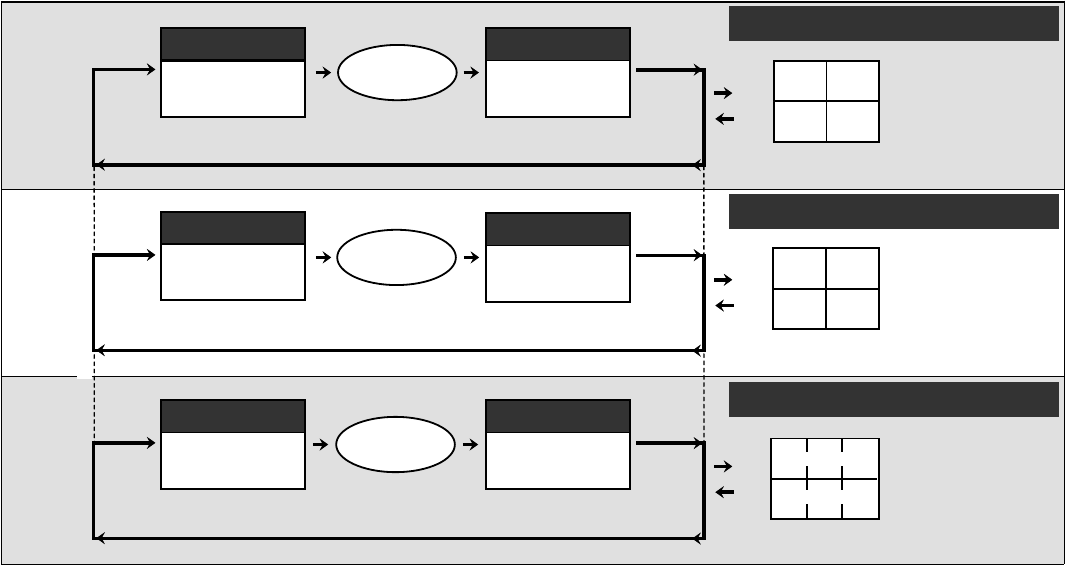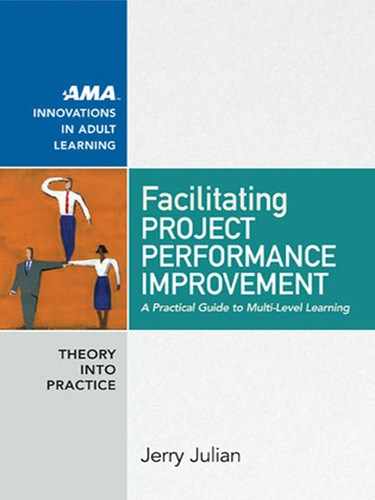4 Introduction
American Management Association
www.amanet.org
MULTI- LEVEL LEARNING: AN APPROACH TO IMPROVING
PROJECT AND PROGRAM PERFORMANCE
Multi- level learning helps to overcome many of the problems that project
organizations face. It helps to reduce risk, deliver faster results, eliminate
waste, and improve teamwork on mission- critical e orts. Its focus is on
facilitating systematic re ection at three levels: strategies, processes, and
projects. In larger organizations, these levels of learning may also re ect
levels of the organization. Senior teams may be primarily responsible for
developing strategy and structuring a portfolio of projects and programs
that will enable the organization to carry out that strategy. Program man-
agers or project management o ce (PMO) leaders may be charged with
sharing practice knowledge across projects to streamline processes, reduce
waste, and shorten delivery time. And project teams may be charged with
the primary responsibility for achieving objectives that deliver results for
external and internal customers (to distinguish internal from external cus-
tomers, in the rest of this book, the former will be called internal clients).
In multi- level learning, teams at each of these levels are empowered to
take primary responsibility for their own learning. And if you’ve worked in
project- intensive environments, you know how important it is to engage
teams at all levels in order to e ect meaningful improvement. After all,
decisions made at each level a ect the others. Achieving business transfor-
mation success means not only delivering successful projects, but also se-
lecting the right projects to begin with. It also means supporting teams by
providing approaches and methodologies that help them carry out their
work in the most e ective way.
Multi- level learning is a closed- loop system that directs actionable feed-
back to the way work gets done at each of these levels. It is not just bottom-
up nor top- down; it is both. Nor is it an end in itself. It is a vehicle for achiev-
ing the organization’s strategic goals, for transforming the way in which
business gets done, and for generating better outcomes on mission- critical
projects and programs, from one phase to the next and from one project
to the next.
Figure I.1 shows the multi- level learning framework. Beginning with
Level 1, project teams are the core driver of innovation, learning, and im-
provement. The focus at this level is on continually innovating and im-
proving projects as they progress, not just re ecting at the end to develop
Introduction 5
American Management Association
www.amanet.org
“lessons learned” that get stored in databases and don’t get used. Instead,
project teams stop and re ect at regular intervals while the project is in
ight so that they can de ne improvements and tangible action items that
can be actively applied during the next phase. The result is learning and
performance improvement as the project progresses, reducing the risk of
project failure, improving team e ectiveness, and providing real- time feed-
back and development opportunities for project members.
In Level 2 of the multi- level learning framework (the cross- project
improvement level), project managers are enlisted, perhaps by a project
or program management o ce, to improve processes that span multiple
projects and programs. At this level, project managers team up and tackle
speci c cross- project problems and opportunities that, when adequately
addressed, will improve delivery e ectiveness across the many projects
in the portfolio, creating a “multiplier” e ect. Process improvement is
at the core of this approach, in which project managers actively re ect
on mission- critical organizational processes, develop speci c strategies
for improving these processes, and test and validate these strategies as
projects progress in order to implement improvements that break down
bureaucracy, reduce waste, eliminate delays, and unlock innovation. This
kind of improvement process is much more powerful and practical than
simply hosting knowledge- sharing sessions or reporting lessons learned
among project managers. The result is real improvement across projects
and buy- in from those who need to implement the change. Engaging proj-
ect managers to improve cross- project processes can reduce costs, improve
productivity, and cut down on the time required to deliver results.
At Level 3 of the multi- level learning framework, senior managers and
sponsors play a pivotal role. Their decisions about strategy and project
selection have wide- ranging implications for the organization. Therefore,
they themselves also engage in periodic re ection on the organization’s
overall project portfolio and its ability to achieve the organization’s strat-
egy. Rather than focusing on a speci c project, the strategy retrospective
is focused on broader programs and strategies, of which projects are only
a part. Questions include: Are the projects in the pipeline enabling the or-
ganization to achieve its intended strategy? What adjustments need to be
made to ensure that we achieve our intended results? Which projects need
to be initiated, cancelled, or repurposed? What actions need to be taken,
and at which levels of the organization?

American Management Association
www.amanet.org
Level 3
Level 2
Program/
Process
Portfolio/
Strategy
Level 1
Project
ÐEliminate non-value-added
spend
ÐCapture strategic program
benefits
ÐImprove mission-critical project
performance
Cross-Project Improvement
Cross-Project Importance
Improvement Potential
L
H
L
H
Reengineer
MonitorMaintain
Quick Hit
ÐRationalize cross-project
redundancies
ÐStreamline cross-project
processes
ÐManage shared resource
allocation/conflict
Continuous Project Improvement
ÐDrive out delays, wait time,
and rework
ÐCorrect and prevent
unfavorable variances
ÐOptimize resource utilization
ÐImprove client and
stakeholder satisfaction
Cost Time Quality
Preventive Actions
Corrective Actions
Project Priority
Project Performance
L
H
L
H
Promote
TurnaroundCancel
Re-
Evaluate
Strategic Portfolio Alignment
Portfolio
Performance
Data
IterateRe-Issue
Portfolio Execution Cycle
Ð Project Life Cycle
Methodologies
Ð Tools &
Templates
Ð Systems & Knowledge
Repositories
Ð Project & Portfolio
Management Processes
Process
Performance
Data
Iterate
Re-Issue
Process Execution Cycle
Ð Stakeholder Management
Plan
Ð Benefits Realization
Plan
Ð Project
Plan
Ð Risk, Issue &
Action Repository
Ð Project
Charter
Project
Performance
Data
IterateRe-Issue
Project Execution Cycle
Ð Strategic
Objectives
Ð Investment
Priorities
Ð Project
Portfolio
Ð Project
Dashboard
Ð Benefits Realization
Schedule
1) Actual Results
2) Causes/Determinants
3) Portfolio Improvements
Strategy
Retrospective
1) Strategic Intent
2) Portfolio Objectives
3) Roles & Responsibilities
4) Key Performance Indicators
Strategy
Prospective
1) Actual Results
2) Causes/Determinants
3) Process Improvements
Process
Retrospective
1) Improvement Objectives
2) Standards & Expectations
3) Roles & Responsibilities
4) Key Performance Indicators
Process
Prospective
1) Actual Results
2) Causes/Determinants
3) Project Improvements
Project
Retrospective
1) Objectives & Deliverables
2) Roles & Responsibilities
3) Time, Cost & Quality Goals
Project
Prospective
Inter-Level Feedback
Ð Process Improvement
Priorities
FIGURE I.1
The Multi-Level Learning Framework
..................Content has been hidden....................
You can't read the all page of ebook, please click here login for view all page.
